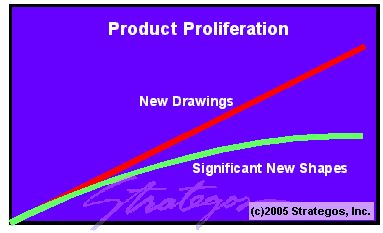Group Technology
Simplify Manufacturing, Design &Purchasing
Unlike Henry Ford, today's manufacturers cannot just make "any color as long as it's black." Fragmented markets, competition and sophisticated customers have created dizzying product variety-- often with lower volume. Numerous firms have choked on this diversity. Increasing inventory, slower product introductions, confusion and declining quality indicate an inability to deal with increasing variety. Group Technology (GT) tames this variety beast.
Group Technology examines products, parts and assemblies. It then groups similar items to simplify design, manufacturing, purchasing and other business processes. The figures below illustrate how an apparently random collection of items has surprising similarity. Group Technology can:
Enable Cellular Manufacturing
Reduce Engineering Cost
Accelerate Product Development
Improve Costing Accuracy
Simplify Process Planning
Reduce Tooling Cost
Simplify Purchasing
Help With Value Stream Mapping
The savings from GT come in many forms, often intangible. Here are some of the improvements that successful users have achieved:
Setup Time................35%-40%
Tooling Cost..............40%
Inventory..................15%-35%
Throughput Time.......80%
Purchased Items......15%
Group Technology is the most effective technique available for addressing the variety demanded by today's customers. It allows customization of product with standardization of process. We have illustrated GT with metalworking for easy visualization. The concept has much wider application. It applies to electronics, paper products, foundry and many other products and services.
GT and Design Engineering

A typical mechanical designer produces about two discrete new parts per week. Thus, even a small department designs hundreds of parts each year. Without formal methods, designers cannot track the drawings. They duplicate or near duplicate many existing parts. Like the Hydra of Greek Mythology, the problem feeds on itself. As more new designs enter the system they become harder to track and encourage even more duplication. GT using Coding and Classification (C&C) addresses this.
GT and Other Departments
GT produces savings and benefits in almost every area of the business. It combines tasks, equipment, gages, tooling and schedules into larger groups of similar elements for similar solutions.
Purchasing can group similar parts and achieve quantity discounts. For non-standard purchased parts, grouping helps suppliers achieve savings and reduce price.
Accounting is simpler in a GT environment. Here costs are collected by cell and family rather than individual part. A simple allocation procedure assigns costs accurately within families.
GT and Manufacturing
Group Technology benefits manufacturing in many ways. It reduces the number and variety of parts. Process planning for the remaining parts is easier and more consistent. Computer Aided Process Planning (CAPP) is an important tool for this. It uses the coded similarities to plan consistently, standardize and accurately estimate costs. It then assigns the part to a GT manufacturing cell.
Group Technology cells reduce throughput time and Work-In-Process. They simplify schedules, reduce transportation and ease supervision. Some of the more dramatic and tangible savings come from improved setups and tooling cost. Setup time reductions bring smaller lot sizes and smaller queues which mean faster throughput, shorter lead times and decreased inventory.
GT sometimes eliminates the need for expensive NC equipment. Combined with NC, GT simplifies programming, fixturing and tooling.
Classification Methods
Classification may be done by several methods.
'Eyeball' and experience suffice when parts are few. Production Flow Analysis considers current
processes and sequences. It groups parts accordingly. Graphics classification is useful for
design standardization and design retrieval. Coding systems are highly versatile in
manufacturing, design and purchasing but they are very expensive because of the labor involved
in the original coding.
![]()
■ ■ ■ ■ ■ ■ ■








